Scottish Crime and Justice Survey 2018/19: main findings
Main findings from the Scottish Crime and Justice Survey 2018/2019.
This document is part of a collection
2. Overview of crime in Scotland
In this report, overall crime measured by the Scottish Crime and Justice Survey (SCJS) is a product of two distinct groups being combined – violent and property crime[6] (see box below).
SCJS Crime Groups
Violent crime includes the following distinct groups:
- Assault (includes serious assault, minor assault with injury, minor assault with no or negligible injury, and attempted assault)
- Robbery
Property crime includes the following distinct groups:
- Housebreaking
- Personal theft (excluding robbery)
- Other household theft (including bicycle theft)
- All motor vehicle related theft (including theft and attempted theft of and from a vehicle)
- Vandalism (including motor vehicle and property vandalism)
Further details on each of these groups is provided in the Technical Report.
What was the extent and prevalence of crime in Scotland in 2018/19?
There were an estimated 573,000 crimes experienced by adults in Scotland in 2018/19.
The SCJS provides an estimate of the number of crimes (or incidence) occurring within Scotland, rounded to the nearest 1,000 crimes. Taking property and violent crime together, the SCJS estimates that overall there were 573,000 crimes experienced by adults in Scotland in 2018/19.
As a sample survey of the general public, SCJS results are estimated values with margins of error, rather than exact counts. Further information on the process used to calculate estimates is contained within the Technical Report. Taking into account confidence intervals, the SCJS estimates that there were between 512,000 and 634,000 incidents of crime in Scotland in 2018/19. The analysis which follows below is focused on the best estimates across each survey year[7].
The overall level of crime experienced in Scotland has fallen by 45% since 2008/09.
The SCJS estimates that the level of crime experienced in Scotland has fallen by 45% since 2008/09. Figure 2.1 displays the trend in the estimated number of SCJS crimes since 2008/09, highlighting a marked decline in crime over the last decade[8]. It also shows the relevant upper and lower estimates for SCJS crime and the best estimates for violent crime and property crime, which are discussed in more detail in later chapters.
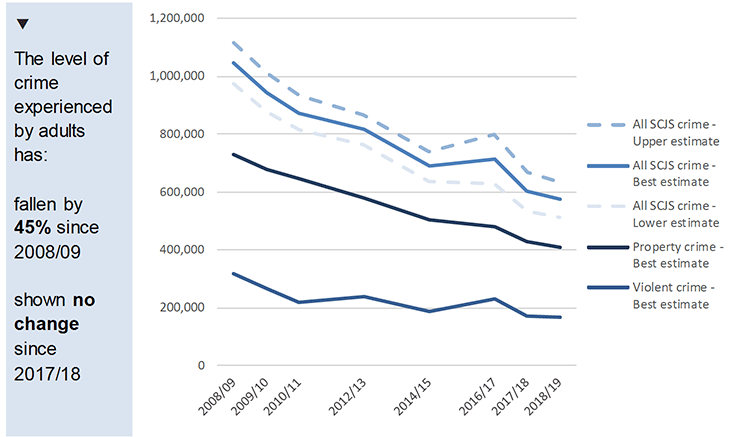
Base: SCJS 2008/09 (16,000); 2009/10 (16,040); 2010/11 (13,010); 2012/13 (12,050); 2014/15 (11,470); 2016/17 (5,570); 2017/18 (5,480); 2018/19 (5,540). Variable: INCSURVEYCRIME
Table 2.1 looks at results from key comparator years[9] more closely and shows that the estimated number of incidents of overall crime experienced by adults:
- decreased by 45% between 2008/09 and 2018/19, from 1,045,000 to 573,000 – an estimated decrease of around 472,000 incidents
- has shown no change since the last SCJS in 2017/18 – the apparent decrease from 602,000 incidents is not statistically significant
| Number of SCJS crimes | 2008/09 | 2017/18 | 2018/19 | Change since 2008/09 | Change since 2017/18 |
|---|---|---|---|---|---|
| Best estimate | 1,045,000 | 602,000 | 573,000 | by 45% | No change |
| Lower estimate | 974,000 | 535,000 | 512,000 | ||
| Upper estimate | 1,116,000 | 668,000 | 634,000 | ||
| Number of respondents | 16,000 | 5,570 | 5,540 |
Base: SCJS 2008/09 (16,000); 2017/18 (5,480); 2018/19 (5,540). Variable: INCSURVEYCRIME
While no change was found in overall crime since 2017/18, this is not an unusual finding from an annual survey like the SCJS. Where crime estimates are based on the experiences of a relatively small number of people, it can often be challenging to detect significant changes between adjacent survey years. That said, where they exist, the SCJS can often identify significant changes and trends over the medium and longer-term.
Looking over a slightly longer period, the estimated number of incidents of overall crime experienced by adults has decreased by 20% since 2016/17, falling from 712,000 incidents to 573,000 in 2018/19. The estimated number of incidents of SCJS crime was lower in 2018/19 than all years between 2008/09 and 2016/17, suggesting there is no clear evidence yet that the decreasing trend in overall crime, as evidenced by the SCJS over the last decade or so, has ended.
The proportion of adults in Scotland experiencing crime has fallen since 2008/09 – from one-in-five to one-in-eight.
Consistent with previous years, the SCJS results show that most adults were not victims of any crime in 2018/19, with 12.4% estimated to have experienced at least one SCJS (property or violent) crime.
As with incident numbers, crime prevalence rates are also estimates derived from a sample survey of the population with associated margins of error around them. Taking into account these confidence intervals, between 11.4% and 13.5% of the adult population were estimated to have experienced at least one SCJS crime in 2018/19, with 12.4% representing the best estimate[10]. Again, as with incident counts, analysis from this point onwards will focus on the best estimates for results across the survey for each year[11].
The proportion of adults experiencing crime has fallen from 20.4% in 2008/09 to 12.4% in 2018/19. In other words, one-in-eight adults were victims of crime in 2018/19 compared to one-in-five in 2008/09.
Since the last SCJS, the proportion of adults experiencing crime has shown no change – the apparent slight decrease from 12.5% in 2017/18 shown in Figure 2.2 is not statistically significant.
Looking slightly further back, the proportion of adults experiencing crime has fallen from 14.5% in 2014/15 to 12.4% in 2018/19 and is now lower than in all years between 2008/09 and 2014/15.
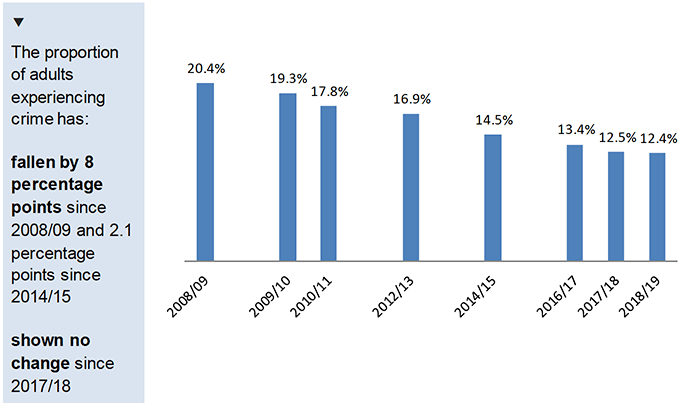
Base: SCJS 2008/09 (16,000); 2009/10 (16,040); 2010/11 (13,010); 2012/13 (12,050); 2014/15 (11,470); 2016/17 (5,570); 2017/18 (5,480); 2018/19 (5,540). Variable: PREVSURVEYCRIME
What type of crime was experienced in Scotland in 2018/19?
As in previous years, most crime in 2018/19 was property-related.
The SCJS collects data on the adult population's experiences of two main types of crime – property and violent crime. It is estimated that 71% of all crime measured by the survey in 2018/19 was property-related, with the remaining 29% being violent incidents – unchanged from 2017/18.
Figure 2.3 below shows the proportion of all crime accounted for by key sub-categories of property and violent crime. Vandalism accounted for just over one-quarter (27%) of all crime measured by the 2018/19 SCJS, with minor assault with no or negligible injury representing just under a fifth of all incidents (17%). Other forms of violence represented relatively small proportions of all crime in Scotland.
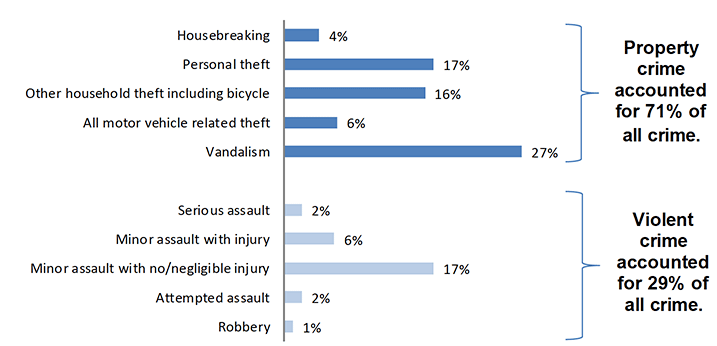
Base: 2018/19 (5,540). Variable: Prevalence (PREV) variables
The SCJS has also consistently shown that adults in Scotland are much more likely to have experienced property crime than violent crime in any given year. It is estimated that 10.9% of adults were victims of property crime in 2018/19, whilst 2.2% experienced violent crime. The prevalence of both property crime and violent crime have fallen since 2008/09.
More detailed results about the extent, prevalence and nature of violent and property crime experienced in Scotland in 2018/19, including how experiences varied across the population and trends over time are provided in the respective 'Focus on violent crime' and 'Focus on property crime' chapters of this report.
How did the likelihood of experiencing crime in 2018/19 vary across the population?
The likelihood of experiencing crime in 2018/19 was higher for those living in deprived areas and people in urban locations. Those aged 60 and over were least likely to be victims.
The proportion of adults who were victims of any SCJS crime in 2018/19 varied according to demographic and geographic characteristics. For instance, as shown in Figure 2.4, the likelihood of experiencing crime in 2018/19:
- was lowest for those aged 60 and over
- was greater for adults in the 15% most deprived areas compared to those living in the rest of Scotland
- was higher in urban areas compared to rural locations
There was no significant difference in the proportion of men and women who were victims of SCJS crime in 2018/19, at 11.5% and 13.4% respectively.
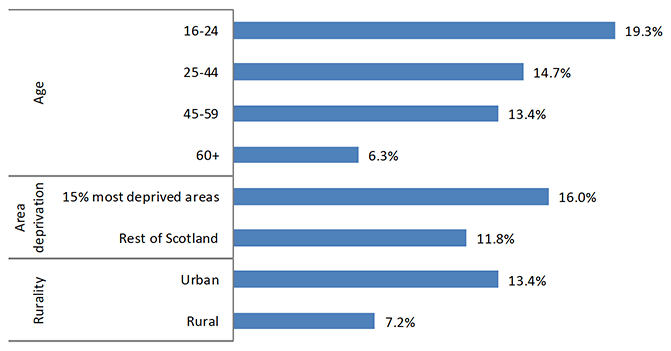
Base: 2018/19 (5,540). Variable: PREVSURVEYCRIME, QDAGE, SIMD_TOP, URBRUR.
The proportion of adults experiencing crime has fallen since 2008/09 across many population groups.
The crime victimisation rate has decreased since 2008/09 across many key groups in the population - including both males and females; all age groups shown above; those living in the most deprived areas as well as those living elsewhere in Scotland; and adults in both urban and rural locations[12].
For example, the proportion of those in the 15% most deprived areas experiencing crime has fallen from 26.0% in 2008/09 to 16.0% in 2018/19 . Over the same period, the prevalence rate for those living elsewhere in Scotland dropped from 19.4% to 11.8%.
In line with the national average, the SCJS detected no change compared to 2017/18 in the overall likelihood of being a victim of crime amongst the demographic sub-groups outlined above.
What can the SCJS tell us about multiple victimisation?
The SCJS also enables us to further explore how experiences varied amongst victims and examine the concentration of crime, including what proportion of victims experienced more than one crime (of any type) during the year. This is known as 'multiple victimisation'. Further information about the approach taken to process and derive SCJS results, including on multiple victimisation, is provided in the Technical Report.
What is multiple and repeat victimisation?
Multiple victimisation examines the proportion of the population which experienced two or more property crimes or two or more violent crimes (known as repeat victimisation), or have been victims of both crime types (i.e. two or more incidents of any crime).
Repeat victimisation is a sub-set of multiple victimisation, the proportion of adults who have been the victim of the same type of crime more than once (e.g. repeat property crimes). Findings on the extent of repeat victimisation for violent and property crime are presented separately in the relevant 'Focus on violent crime' and 'Focus on property crime' chapters of this report.
3.5% of adults experienced multiple victimisation in 2018/19, accounting for just over half (55%) of all SCJS crime.
As discussed above, the majority of adults (87.6%) did not experience any crime measured by the SCJS in 2018/19, and conversely 12.4% were victims of at least one property or violent crime.
Examining the volume of crime experienced by individual victims more closely reveals that just under one-in-ten adults (8.9%) were victims of a single incident of SCJS crime in 2018/19, accounting for 45% of all crime.
It is therefore estimated that multiple victimisation affected 3.5% of the adult population in 2018/19, and that this group experienced just over half (55%) of all SCJS crime during the year. These victims are estimated to have experienced two crimes each on average.
Table 2.2 highlights these results in more detail.
Table 2.2: Proportion of all SCJS crime experienced by victims, by number of crimes experienced in 2018/19
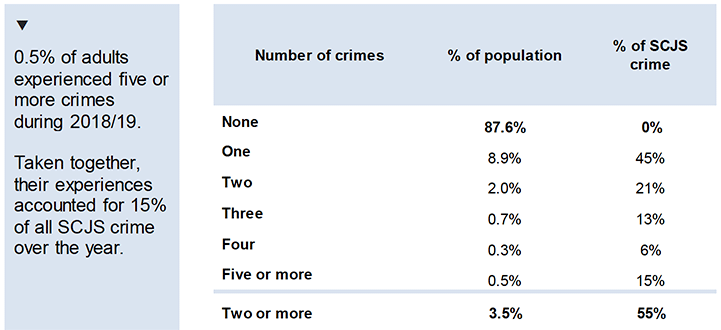
Base: SCJS 2018/19 (5,540). Variable: INCSURVEYCRIME, PREVSURVEYCRIME.
The likelihood of experiencing multiple victimisation has fallen since 2008/09.
Figure 2.5 explores trends in single and multiple victimisation over time. It highlights that between 2008/09 and 2018/19 there were decreases in the proportion of adults experiencing:
- single incidents of SCJS crime – from 12.2% to 8.9%
- multiple victimisation (two or more incidents of SCJS crime) – from 8.2% to 3.5%
- high frequency multiple victimisation (five or more incidents of SCJS crime) – from 1.5% to 0.5%
The fall in the various levels of victimisation since 2008/09 has occurred alongside a fall in the overall SCJS crime victimisation rate[13] over this period, as discussed previously.
Since the last SCJS in 2017/18, there has been no change in the proportion of adults experiencing single or multiple victimisation – any apparent differences shown in Figure 2.5 are not statistically significant.
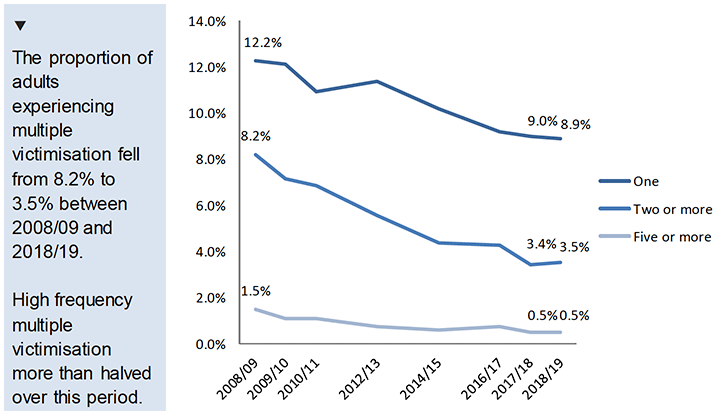
Base: SCJS 2008/09 (16,000); 2009/10 (16,040); 2010/11 (13,010); 2012/13 (12,050); 2014/15 (11,470); 2016/17 (5,570); 2017/18 (5,480); 2018/19 (5,540). Variable: INCSURVEYCRIME, PREVSURVEYCRIME.
In summary these findings show that, compared to 2008/09, adults in 2018/19 were less likely to be victims of:
- at least one SCJS crime
- one SCJS crime specifically
- more than one SCJS crime
What proportion of crime was reported to the police in 2018/19?
It is estimated that the police became aware of 36% of crime in 2018/19, a similar proportion to previous years.
One of the key strengths of the SCJS is that it provides evidence on the extent of crime experienced by the population, including incidents which are not reported to the police. For this reason, the SCJS and police recorded crime statistics are complementary sources that, together, present a fuller picture of crime in Scotland. The 'Bringing together crime statistics' chapter of this report explores the differences and similarities between the SCJS and recorded crime (including trends over time) in more detail.
The SCJS estimates that 36% of all SCJS (property and violent) crime in 2018/19 came to the attention of the police. This proportion has shown no change since 2008/09. It is estimated that 34% of property crimes were reported to the police in 2018/19, compared to 40% of violent incidents – although this apparent difference in reporting rates is not statistically significant. Further information on the reporting rates and the reasons behind non-reporting are presented in the 'Focus on violent crime' and 'Focus on property crime' chapters.
How did the likelihood of experiencing crime in Scotland compare to England and Wales?
Victimisation surveys take place in many jurisdictions across the world to obtain information on the relevant population's experience of crime. However comparisons between surveys can often be challenging due to methodological differences.
That said, the SCJS is similar to the Crime Survey for England and Wales (CSEW), with both surveys following on from the British Crime Survey (BCS). Although there are some differences between the surveys, for example the coding of crimes varies between the SCJS and the CSEW to reflect the different criminal justice systems in which they operate, the overall results on the proportion of adults experiencing crime have offered a broad comparison point over the years.
Following recent updates to the methodology used in the CSEW to produce estimates for the volume of crime experienced by the adult population, we assess that the results on the overall victimisation rate remain broadly comparable between the two surveys. A short methodological paper is available which confirms the approach currently taken to produce crime estimates in the SCJS and its relative strengths and limitations.
Further information on the similarities and differences between the SCJS and CSEW are provided in the SCJS 2018/19 Technical Report.
In 2018/19, adults in Scotland were less likely to have experienced crime than those in England and Wales.
Looking at the overall crime victimisation rates, the proportion of adults estimated to have experienced crime in 2018/19 was lower in Scotland (12.4%) than in England and Wales (14.9%).
This continues the finding from 2017/18 and is a change to the position in 2016/17 – where no significant difference was detected between the victimisation rates in Scotland and England and Wales. However, as shown by Figure 2.6, the prevalence rate has been lower in Scotland in the past. It will be important to continue monitoring these figures going forward, to help determine if trends between the two jurisdictions are diverging.
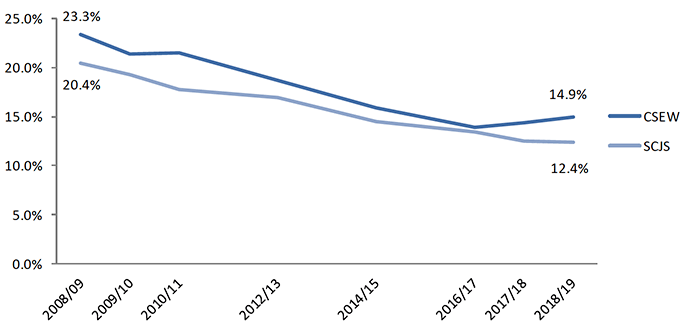
SCJS prevalence – Base: 2008/09 (16,000); 2009/10 (16,040); 2010/11 (13,010); 2012/13 (12,050); 2014/15 (11,470); 2016/17 (5,570); 2017/18 (5,480); 2018/19 (5,540). Variable: PREVSURVEYCRIME.
CSEW prevalence – Base: 2018/19 (34,160).
Contact
Email: scjs@gov.scot
There is a problem
Thanks for your feedback